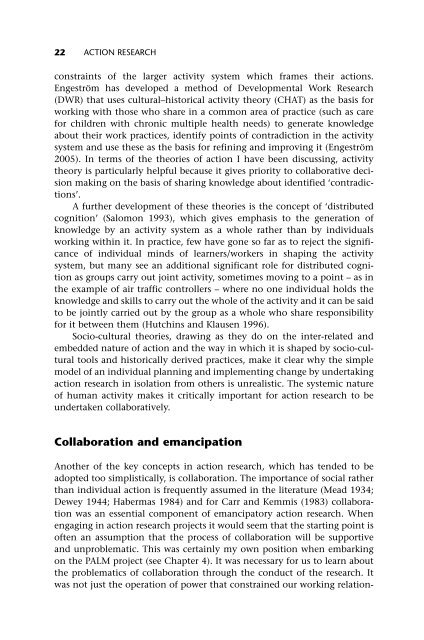Action Research A Methodology for Change and Development
Action Research A Methodology for Change and Development
Action Research A Methodology for Change and Development
You also want an ePaper? Increase the reach of your titles
YUMPU automatically turns print PDFs into web optimized ePapers that Google loves.
22 ACTION RESEARCH<br />
constraints of the larger activity system which frames their actions.<br />
Engeström has developed a method of <strong>Development</strong>al Work <strong>Research</strong><br />
(DWR) that uses cultural–historical activity theory (CHAT) as the basis <strong>for</strong><br />
working with those who share in a common area of practice (such as care<br />
<strong>for</strong> children with chronic multiple health needs) to generate knowledge<br />
about their work practices, identify points of contradiction in the activity<br />
system <strong>and</strong> use these as the basis <strong>for</strong> refining <strong>and</strong> improving it (Engeström<br />
2005). In terms of the theories of action I have been discussing, activity<br />
theory is particularly helpful because it gives priority to collaborative decision<br />
making on the basis of sharing knowledge about identified ‘contradictions’.<br />
A further development of these theories is the concept of ‘distributed<br />
cognition’ (Salomon 1993), which gives emphasis to the generation of<br />
knowledge by an activity system as a whole rather than by individuals<br />
working within it. In practice, few have gone so far as to reject the significance<br />
of individual minds of learners/workers in shaping the activity<br />
system, but many see an additional significant role <strong>for</strong> distributed cognition<br />
as groups carry out joint activity, sometimes moving to a point – as in<br />
the example of air traffic controllers – where no one individual holds the<br />
knowledge <strong>and</strong> skills to carry out the whole of the activity <strong>and</strong> it can be said<br />
to be jointly carried out by the group as a whole who share responsibility<br />
<strong>for</strong> it between them (Hutchins <strong>and</strong> Klausen 1996).<br />
Socio-cultural theories, drawing as they do on the inter-related <strong>and</strong><br />
embedded nature of action <strong>and</strong> the way in which it is shaped by socio-cultural<br />
tools <strong>and</strong> historically derived practices, make it clear why the simple<br />
model of an individual planning <strong>and</strong> implementing change by undertaking<br />
action research in isolation from others is unrealistic. The systemic nature<br />
of human activity makes it critically important <strong>for</strong> action research to be<br />
undertaken collaboratively.<br />
Collaboration <strong>and</strong> emancipation<br />
Another of the key concepts in action research, which has tended to be<br />
adopted too simplistically, is collaboration. The importance of social rather<br />
than individual action is frequently assumed in the literature (Mead 1934;<br />
Dewey 1944; Habermas 1984) <strong>and</strong> <strong>for</strong> Carr <strong>and</strong> Kemmis (1983) collaboration<br />
was an essential component of emancipatory action research. When<br />
engaging in action research projects it would seem that the starting point is<br />
often an assumption that the process of collaboration will be supportive<br />
<strong>and</strong> unproblematic. This was certainly my own position when embarking<br />
on the PALM project (see Chapter 4). It was necessary <strong>for</strong> us to learn about<br />
the problematics of collaboration through the conduct of the research. It<br />
was not just the operation of power that constrained our working relation-

















